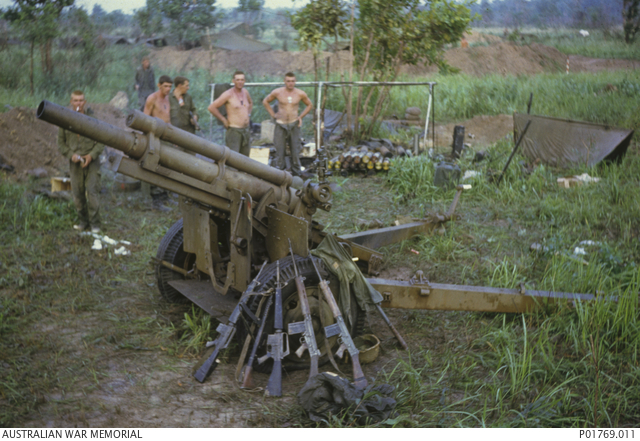Coral and Balmoral, battle of Fire Support Bases
During the "Mini-Tet" offensive mounted by Viet Cong and North Vietnamese forces in May 1968, the 1st Australian Task Force deployed two battalions to an area 20 kilometres north of Bien Hoa city to intercept and disrupt enemy forces withdrawing from the capital, Saigon, and the Bien Hoa–Long Binh base complex. Several fire support bases (FSB) were established to provide defended firing points for artillery and mortars which would cover foot patrols to be sent out by the battalions (1RAR and 3RAR). One of these FSBs was dubbed "Coral", situated 7 kilometres north of the town of Tan Uyen.
Fire Support Base Coral, Bien Hoa province, Vietnam. 13 May 1968. A 105 mm M2A2 howitzer, the No. 6 gun of 102 Field Battery, 12th Field Regiment, Royal Australian Artillery. C269848
Occupation of Coral was begun on 12 May, but the defences remained unfinished when, at about 3.30 am on 13 May, it was attacked following a brief but intense rocket and mortar barrage. The 1RAR mortar platoon position was over-run, along with one of 102 Field Battery's six 105 mm M2A2 howitzers in the base. With the aid of extensive air support, the attack was beaten off by 6.30 am and the captured gun-pit was retaken – still with the gun in it (this howitzer is now on display in the Vietnam gallery at the Australian War Memorial). Eleven Australians were killed and 28 wounded, while the attackers lost more than the 52 bodies they left behind. A further three Australians died in patrol clashes on the 14 May.
At 2.30 am on 16 May Coral again came under attack, this time from a North Vietnamese Army (NVA) force estimated at three battalions strong. The base was now defended by armoured personnel carriers of A Squadron, 3rd Cavalry Regiment, and 1RAR's rifle companies, all of which were heavily engaged; part of the A Company position was occupied for a period, but the enemy was forced to withdraw. The attack was repelled after four hours of fighting, with the Australians having suffered five men killed and 19 wounded. Two members of an American battery which had reinforced the base were also wounded. Only 34 enemy bodies were recovered, but blood trails and drag marks indicated that many more casualties had been removed.
Howitzer from FSB Coral that is now on display in the Conflicts 1945 to today galleries. C355767
On 22 May Coral was subjected to yet another rocket and mortar barrage, but this time the NVA troops were dispersed by return fire from 1RAR's mortars as they formed up to attack. Although there were further bombardments on 26 and 28 May, and patrols sent out from the base came into contact with the enemy, Coral was not seriously threatened again. During fighting on 26 May the base's defenders even turned the tables on the NVA by sending a troop of Centurion tanks from C Squadron, 1st Armoured Regiment (which had arrived as reinforcements three days earlier), outside the perimeter wire with infantry support; these engaged and destroyed most of a NVA bunker system that had been discovered.
Enemy efforts on 26 May were primarily focused on another FSB named "Balmoral", which was established about 4.5 kilometres further north on 24–25 May by 3RAR supported by tanks. The defenders threw back assaults launched against Balmoral on 26 and 28 May. On the latter occasion, the attacking NVA regiment lost at least 42 killed and seven prisoners, but again casualties were thought to have been higher.
Sources
- Ian McNeill and Ashley Ekins, On the offensive: The Australian Army in the Vietnam War 1967–1968, Allen & Unwin in association with the Australian War Memorial, Sydney, 2003
Further Information
- The battles of Coral & Balmoral: May-June 1968 (Australian War Memorial blog)
Includes Honour Roll and links to maps and collection items - Australian Army commanders' diaries: Vietnam War (AWM95)
Read the commanders' diary entries for 1RAR and 3RAR, May 1968 - Australia's Vietnam War: exploring the combat actions of the 1st Australian Task Force
Database and website developed by the University of New South Wales Canberra which combines combat data with mapping and graphing software to produce an interactive battle map of the campaign in Vietnam. Incorporates maps from both the present day and the Vietnam War era to display details of combat incidents involving Australian and New Zealand troops from the 1st Australian Task Force in Vietnam in the 1960s and 1970s.
- The battles of Coral & Balmoral: May-June 1968 (Australian War Memorial blog)

